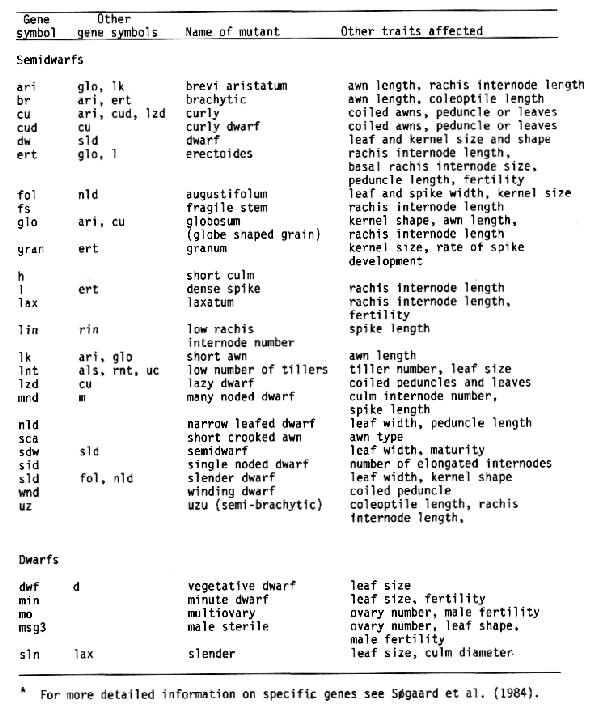

The development of a collection for semidwarf barleys has raised a question regarding definitions for the terms dwarf and semidwarf as applied to barley genes. Smith (1951) classified plants homozygous for the br, mnd, or uz genes as dwarfs. Also, he described a dominant dwarf D reported by Miyazawa in 1921 which produced a completely sterile homozygote. A gibberellic acid sensitive vegetative dwarf was reported by Falk and Kasha (1982) and the gene symbol dwf was suggested. The 'Jotun' mutant and similar mutants have been classified as semidwarfs by many researchers (Hockett and Nilan, 1985). The gene symbol sdw was suggested for the Jotun gene by Ali et al. (1978). Haahr and von Wettstein (1976) reported that the Jotun gene is allelic to several other mutant genes for reduced height. Variation for height among plant stature genes which are viable as homozygotes seems to be continuous. Genetic background or environmental factors, photoperiod in the case of the uz gene, can modify greatly the percent height reduction caused by a given gene. Only the vegetative dwarfs seem to be a distinct group. Thus, I suggest that all reduced height mutants of barley which are viable as homozygotes be considered semidwarfs. The non-viable height mutants should be referred to as dwarfs.
Assigning gene symbols to reduced height mutants is a problem because many mutants have pleiotropic effects on traits other than culm length. Various researchers have considered other morphological traits as the primary effect of a given gene and assigned a gene symbol based on that trait or a combination of traits. At the 5th International Barley Genetics Symposium, the International Committee for Nomenclature and Symbolization for Barley Genes recommended that where feasible the first symbol suggested for a gene be retained. Because assigned names and gene symbols do characterize well the phenotypic effect of most plant height mutants, new symbols should be suggested only for semidwarfs which cannot be placed conveniently into a previously assigned gene symbol group. The new plant height genes which cannot be classified based on pleiotropic effects could be assigned symbols in the sdw series for semidwarfs or the dwf series for dwarfs.
The pleiotropic effects of various genes which may reduce plant height also have lead to assignment of different gene symbols to phenotypically similar mutants or alleles. To aid in classification of semidwarf and dwarf mutants, many previously assigned gene symbols are listed in Table 1. The list can be a guide for evaluation of morphological effects associated which a given gene symbol, but for more detail the genetic stock description for each gene in the Barley Genetics Newsletter should be consulted.

References:
Ali,M.A.M., S.O. Okiror, and D.C. Rasmusson. 1978. Performance of semi-dwarf barley. Crop Sci. 18:418-422.
Falk, D.E., and K.J. Kasha. 1982. A vegetative dwarf mutant in barley. Barley Genet. Newsl. 12:69-72.
Haahr, V., and D. von Wettstein. 1976. Studies of an induced high- yielding dwarf-mutant of spring barley. p. 215-218. In H. Gaul (ed.) Barley Genet. III. Proc. 3rd. Int. Barley Genetic Symp. Garching, Federal Republic of Germany.
Hockett, E.A., and R.A. Nilan. 1985. Genetics. p. 187-230. In D.C. Rasmusson (ed.) Barley. American Society of Agronomy, Madif-s-on, Wisconsin.
Smith, L. 1951. Cytology and genetics of barley. Bot. Rev. 17:1- 51; 133-202; 285-355.
Søgaard, B., R.A. Nilan, and D. von Wettstein. 1984. Masterlist of barley genes. Barley Genet. Newsl.14:140-172.